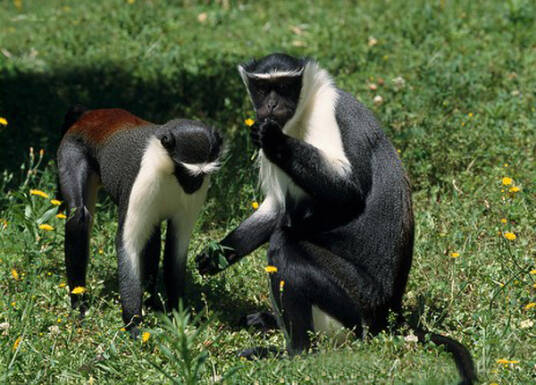Cercopithecus diana
IUCN
LCBasic Information
Scientific classification
- name:Cercopithecus diana
- Scientific Name:Cercopithecus diana,Diana Monkey,Diana's monkey, Diana's monkey
- Outline:Primates
- Family:Cercopithecidae Cercopithecidae
Vital signs
- length:42-61cm
- Weight:4-8.7kg
- lifetime:About 20 years
Feature
The cheeks and body are mostly black, there is a white stripe on the thigh, and there is a red patch on the back
Distribution and Habitat
Distributed in the forests of West Africa, Sierra Leone, Liberia, southern Côte d'Ivoire and southwestern Ghana. Extending to Burkina Faso. Historical records show that this species was also once distributed east of Lake Volta in Togo.
There are two subspecies, the nominate subspecies ranges from the southeastern coast of Guinea to the Sassandra River in Côte d'Ivoire; the Ghana subspecies ranges from the Sassandra River to the east of the Pragana River.
Diana's long-tailed monkeys live in primary and secondary forests, active in the canopy of moist lowland forests and forest woodlands near rivers, and are rare in degraded forest areas.
Appearance
Diana's long-tailed monkey is a medium-sized monkey. The male head and body length is 51-61 cm, and the female head and body length is 42-45 cm; the male tail is 76-90 cm, and the female tail is 52-72 cm; the male weighs 5-8.7 kg, and the female weighs 4-5 kg. The snout is prominent, the two jaws are thick, there are 32 teeth, the nostrils are facing forward and downward, and the hands and feet have 5 fingers and toes, with flat nails that can stand upright. There are cheek pouches for storing food. The tooth tips are low, and the tooth formula is: 2/2, 1/1, 2/2, 2/3 = 32.
The body hair is generally black or dark gray, the throat is white, and the eyebrows and beard are crescent-shaped. Because their eyebrows resemble the bow of Diana in Roman mythology, they are named so. They have a slender body and long legs, and the whole body and tail form a long "question mark" curve when walking. The cheeks are black, with thick white beards and eyebrow lines. The back and lowe
Details
Diana's long-tailed monkey (scientific name: Cercopithecus diana) is also known as Diana Monkey in English. It is a tree-dwelling long-tailed monkey with two subspecies.

Diana's long-tailed monkey is a diurnal animal. They live in trees during the day and rarely come to the ground. They will forage anywhere in the canopy and go to higher places to rest at night. Their special fur color can provide a variety of visual signals, and they can also issue a variety of warning signals, with different calls for different predators. However, the yellow-helmeted black hornbill can distinguish these warnings and take corresponding actions. They mainly eat fruits and insects, but also flowers, young leaves and invertebrates; their natural enemies include crowned eagles, leopards, chimpanzees and humans.
Diana's long-tailed monkeys can live up to 20 years. Their group consists of only one male monkey, several female monkeys and their young monkeys. Generally speaking, female monkeys can also give birth every year. The gestation period is 5 months, and the young monkeys need 6 months of care. Only one baby monkey is born per litter. Even if the baby monkey is in good condition at birth, the mother monkey will be very nervous and rarely let the baby monkey leave her. The young monkeys like to play. The young monkeys reach sexual maturity at the age of 3. Female monkeys will stay with the group of female monkeys, while male monkeys will leave.
The main threats to Diana's long-tailed monkeys are habitat loss and hunting. The habitat of this species has been severely degraded and lost due to large-scale deforestation and logging by humans, and the conversion of forests into agricultural land and charcoal production. Humans also hunt this species for its meat or fur due to its relatively large size, which is the reason for the decline in the number of this species.
Protect wild animals and stop eating game.
Maintaining ecological balance is everyone's responsibility!








